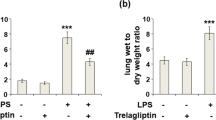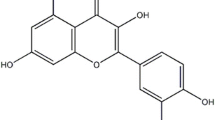Abstract
Formononetin has shown a variety of pharmacologic properties including anti-inflammatory effect. In the present study, we analyzed the role of formononetin in acute lung injury induced by lipopolysaccharide (LPS) in mice. The cell counting in the bronchoalveolar lavage fluid (BALF) was measured. The animal lung edema degree was evaluated by wet/dry weight ratio. The superoxidase dismutase (SOD) activity and myeloperoxidase (MPO) activity was assayed by SOD and MPO kits, respectively. The levels of inflammatory mediators, tumor necrosis factor-α (TNF-α) and IL-6,were assayed by enzyme-linked immunosorbent assay method. Pathological changes of hung tissues were observed by HE staining. Peroxisome proliferator-activated receptor (PPAR)-γ gene expression was measured by real-time PCR. The data showed that treatment with the formononetin group markedly attenuated inflammatory cell numbers in the BALF, increased PPAR-γ gene expression and improved SOD activity and inhibited MPO activity. The histological changes of the lungs were also significantly improved by formononetin compared to LPS group. The results indicated that formononetin has a protective effect on LPS-induced acute lung injury in mice.






Similar content being viewed by others
References
Kollef, M.H., and D.P. Schuster. 1995. The acute respiratory distress syndrome. The New England Journal of Medicine 332: 27–37.
Worthen, G.S., C. Haslett, A.J. Rees, R.S. Gumbay, J.E. Henson, and P.M. Henson. 1987. Neutrophil-mediated pulmonary vascular injury: synergistic effect of trace amounts of lipopolysaccharide and neutrophil stimuli on vascular permeability and neutrophil sequestration in the lung. The American Review of Respiratory Disease 136: 19–28.
Desvergne, B., and W. Wahli. 1999. Peroxisome proliferator activated receptors: nuclear control of metabolism. Endocrine Reviews 20(5): 649–688.
Berger, J., and D.E. Moller. 2002. The mechanisms of action of PPARs. Annual Review of Medicine 53: 409–435.
Denning, G.M., and L.L. Stoll. 2006. Peroxisome proliferator activated receptors: potential therapeutic targets in lung disease? Pediatric Pulmonology 41(1): 23–34.
Benayoun, L., S. Letuve, A. Druilhe, et al. 2001. Regulation of peroxisome proliferator-activated receptor γ expression in human asthmatic airways: relationship with proliferation, apoptosis, and airway remodeling. American Journal of Respiratory and Critical Care Medicine 164(8 I): 1487–1494.
Duez, H., J.C. Fruchart, and B. Staels. 2001. PPARs in inflammation, atherosclerosis and thrombosis. Journal of Cardiovascular Risk 8(4): 187–194.
Spinelli, S.L., J.J. O’Brien, and S. Bancos, et al. 2008. The PPAR platelet connection: modulators of inflammation and potential cardiovascular effects. PPAR Research vol. 2008, Article ID 328172, 16 pages.
Ameshima, S., H. Golpon, C.D. Cool, et al. 2003. Peroxisome proliferator-activated receptor gamma (PPARγ) expression is decreased in pulmonary hypertension and affects endothelial cell growth. Circulation Research 92(10): 1162–1169.
Sinclair, S. 1998. Chinese herbs: a clinical review of Astragalus, Ligusticum, and Schizandrae. Alternative Medicine Review 3: 338–344.
Miller, A.L. 1998. Botanical influences on cardiovascular disease. Alternative Medicine Review 3: 422–431.
Tang, H.F., J.J. Lu, J.F. Tang, X. Zheng, Y.Q. Liang, X.F. Wang, et al. 2010. Action of a novel PDE4 inhibitor ZL-n-91 on lipopolysaccharide-induced acute lung injury. International Immunopharmacology 10(4): 406–411.
Valentina, P., C.L. Marchica, and M.S. Ludwig. 2009. Physiology &Neurobiology 169: 36–43.
Rubenfeld, G.D. 2003. Epidemiology of acute lung injury. Critical Care Medicine 31: 276–284.
Knapp, S., S. Florquin, D.T. Golenbock, and T. van der Poll. 2006. Pulmonary lipopolysaccharide (LPS)-binding protein inhibits the LPS-induced lung inflammation in vivo. Journal of Immunology 176: 3189–3195.
Chen, H., C. Bai, and X. Wang. 2010. The value of the lipopolysaccharide-induced acute lung injury model in respiratory medicine. Expert Review of Respiratory Medicine 4: 773–783.
Cepkova, M., and M.A. Matthay. 2006. Pharmacotherapy of acute lung injury and the acute respiratory distress syndrome. Journal of Intensive Care Medicine 21: 119–143.
Wang, Q., P. Teder, N.P. Judd, P.W. Noble, and C.M. Doerschuk. 2002. CD44 Deficiency leads to enhanced neutrophil migration and lung injury in escherichia coli pneumonia in mice. The American Journal of Pathology 161: 2219–2228.
Abraham, E. 2003. Neutrophils and acute lung injury. Critical Care Medicine 31: 195–199.
Klebanoff, S.J. 2005. Myeloperoxidase: friend and foe. Journal of Leukemia Biology 77: 598–625.
Chawla, A., Y. Barak, L. Nagy, D. Liao, P. Tontonoz, and R.M. Evans. 2001. PPAR-gamma dependent and independent effects on macrophage-gene expression in lipid metabolism and inflammation. Nature Medicine 7: 48–52.
Kelly, D., J.I. Campbell, T.P. King, G. Grant, E.A. Jansson, A.G. Coutts, S. Pettersson, and S. Conway. 2004. Commensal anaerobic gut bacteria attenuate inflammation by regulating nuclear-cytoplasmic shuttling of PPAR-gamma and RelA. Nature Immunology 5: 104–112.
Lee, C.H., A. Chawla, N. Urbiztondo, D. Liao, W.A. Boisvert, R.M. Evans, and L.K. Curtiss. 2003. Transcriptional repression of atherogenic inflammation: modulation by PPARdelta. Science 302: 453–457.
Acknowledgments
This work was supported by Project Funded by the Priority Academic Program Development of Jiangsu Higher Education Institutions.
Author information
Authors and Affiliations
Corresponding authors
Rights and permissions
About this article
Cite this article
Ma, Z., Ji, W., Fu, Q. et al. Formononetin Inhibited the Inflammation of LPS-Induced Acute Lung Injury in Mice Associated with Induction of PPAR Gamma Expression. Inflammation 36, 1560–1566 (2013). https://doi.org/10.1007/s10753-013-9700-5
Published:
Issue Date:
DOI: https://doi.org/10.1007/s10753-013-9700-5




